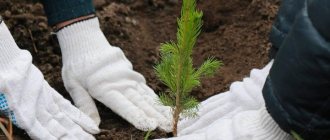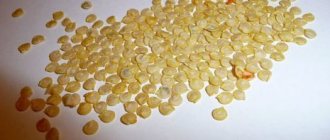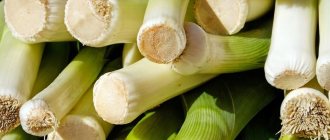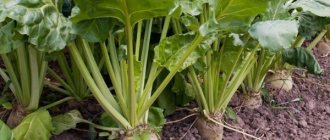Selection of varieties and seeds
Beets are unpretentious and ready to grow in all latitudes, with the exception of permafrost. You can opt for regionalized local varieties or experiment with new hybrids with increased hardiness.
The ripening period of beets depends on the variety and ranges from 80 to 130 days. You can adjust the ripening time by planting beets under a greenhouse or seedlings, first germinating the seeds.
The most popular varieties suitable for growing in any climatic conditions:
Valenta is an early ripening variety with sweet, dark red flesh, cold-resistant, shelf-stable, and disease-resistant.
Ataman is a medium-late variety, the fruits are cylindrical, weighing 300 g, burgundy, sweet with uniform pulp, very well stored.
Cylindra is a mid-late variety with an elongated bright red fruit, weighing up to 500 g, strong immunity and good keeping quality.
Podzimnyaya is a mid-early cold-resistant variety, resistant to most diseases, round fruits weighing 200 - 400 g with burgundy pulp.
Red Bogatyr is a mid-early, high-yielding variety; the fruits are cylindrical, dark red, with thin skin and uniform pulp, weighing 200–550 g.
Red ice is a mid-early variety, the fruits are bright red, with structured pulp, light in weight - 200–300 g, and can be stored well.
Bicores is a mid-season, high-yielding variety, bright red fruits weighing 200-350 g, long-lasting.
If you plan to eat beets from your garden all year round, then you need to plant both early and late varieties of beets.
Late varieties
Beets tolerate cold without problems. Therefore, a temperature of 2–3 °C is not an obstacle to full development. Of course, we are talking about late varieties. Table beets have a later digging period and are harvested in mid-autumn. Late varieties are much tastier than early ones.
In addition to taste, the crop is distinguished by good yield. The collection of root crops depends on the size. Small ones are left in the ground until fully ripe, and large ones are selected immediately. It will take some more time for the small fruits to grow and be ready to be harvested.
You can dig up beets according to the Lunar calendar. It is better to harvest fruits during the waning moon. There is no specific date for each year, as it is constantly changing. This is mainly in autumn, towards mid-October.
The date for collecting root crops depends on the location of germination. Moderate climatic conditions promote faster ripening of crops than dry or cold weather.
Landing dates
More often, beets are planted in the spring, when the air warms up to 15-18 C. You can do this a little earlier, in April by planting ungerminated seeds under a greenhouse.
If the spring is too cold, you can move the planting date to a later time, choosing early ripening beets.
Winter beets are sown with dry seeds before the onset of frost. Only specially oriented varieties are selected for this purpose. The crop areas are covered. They begin to grow in early spring and provide a summer beet harvest. Summer-ripened root crops cannot be stored for long periods of time.
Preparing the soil for beets
The soil is dug up in the fall after careful harvesting of the previous harvest. Organic components (compost or manure) are applied as deeply as possible - 30-35 centimeters. You can organize some semblance of a warm bed, but with a thin layer of organic matter so that it has time to decompose by the time the beet root grows into it.
The acidity of the earth is reduced by scattering dolomite flour, ground eggshells or wood ash.
It is better to apply mineral additives - superphosphate and potassium sulfate - in the fall so that they have time to dissolve in the soil. They are scattered dry over the bed before digging at a rate of no more than 0.3 kg. per square meter of land.
The root crop develops better in loose soil. In the spring, it is good to dig up the bed again and mulch it with peat or rotted sawdust.
How to prepare seeds
Beets take quite a long time to ripen. On average, this takes 3–4 months. And in order for the seeds to sprout faster, they must first be soaked. A special solution is prepared for this. For 1 liter of water you will need any of these products:
- a quarter teaspoon of boric acid and half a teaspoon of nitrophoska;
- 1 tbsp. l. wood ash;
- 1 tsp. superphosphate;
- 1 tsp. baking soda.
Keep the seeds in the solution for no more than a day, otherwise they will spoil. They are then washed, wrapped in a damp cloth and left for several days. If the bundle begins to dry out, moisten it a little with water. After this, the beets are sown in the ground or for seedlings.
Important. Before autumn planting, pre-soaking the seeds is not required.
Site selection, crop rotation
Rules for choosing a place for beets:
- beets love space; the sparser the root crops are planted from each other, the more space they have for growing rounded barrels;
- if there is no need for large plantations of this root crop, beets can be planted in a border method next to potatoes, cucumbers, beans, next to greens or onions;
- beets need frequent irrigation, but stagnation of water will lead to rotting, which means the bed must be laid out next to the watering source in a well-drained area;
- Beets are not planted twice in a row in the same place; crop rotation is observed very carefully;
- the preceding plants for this vegetable are onions, garlic, potatoes, tomatoes, eggplants, carrots, zucchini;
- It is undesirable to plant beets after cabbage and for the second year in a row in one place.
If you have to displace any crops in the garden by planting them on poor soil, then you can safely do this with beets. Its growth can be ensured by good loosening of the soil, timely watering and fertilizer.
Preparatory stage
Before sowing seeds in the garden, they need to be prepared. The same applies to the beds where beets are supposed to be grown.
The best predecessors
Before beets, nightshade, pumpkin, green crops, cereals, legumes, garlic and onions can grow in the selected area. It is not recommended to plant it after root crops, potatoes, cabbages, fodder and sugar beets.
Site selection and soil preparation
The beds for beets should be selected in a sunny area, open, but not blown by strong winds. Beets love fertile, soft, loose soil; the mechanical composition of the soil should be sandy loam or loamy, preferably neutral acidity.
Site preparation is carried out in the fall: plant debris is removed from the surface of the beds, the soil is dug with a shovel to a depth of at least 25 cm, and fertilizers are simultaneously added to it. In autumn, it is best to use organic matter, that is, compost or humus (1-2 buckets per sq. m) and ash (up to 0.5 kg). It is important not to exceed the dose of fertilizers, especially nitrogen ones, since an excess of elements can cause root crops to be loose, with voids and cracks. Acidic soils are limed.
Seed preparation
Beet seeds sold in vegetable stores are usually already treated with protective substances and growth stimulants (this can be recognized by the brightly colored shell), so they do not need any processing. They are sown dry directly into the ground, without soaking or disinfecting.
Seeds collected from domestic plants must be sorted and soaked for better germination. First of all, unsuitable ones are rejected, that is, small, inferior ones, with defects. To do this, pour them into a container, fill them with saline solution (50 g per 1 liter) and then pour out the floating seeds. Those remaining at the bottom are soaked in a solution of growth stimulants for the time specified in the instructions for the drug, and then in warm water for 1 day. Then remove from the water and dry a little.
Seed preparation
Beet seeds before planting:
- check for germination - pour into a glass of salted water, mix and remove any that float;
- hardened by alternating hot water and cold, maintaining each temperature for several hours;
- disinfected by keeping for 12 hours in a weak solution of potassium permanganate;
- stimulated by soaking in a growth stimulator.
- germinate if the seeds are prepared for growing beet seedlings.
For pre-winter planting, you need to limit yourself only to checking for germination and disinfection - excessively swollen seeds can germinate in the winter and die.
Beet care
The process of growing beets includes watering, fertilizing, loosening and mandatory thinning.
Beets do not require close attention at all if they grow in good soil and with proper watering. But if the plant lacks nutrition, it will have a bad effect on taste or lead to diseases.
- Phomosis of beet fruits and leaves develops with a lack of boron and is expressed in the appearance of lightened spots on the foliage; it is also fraught with curvature and the appearance of cavities in the root crop.
- Cercospora blight is caused by excessive moisture in the beds.
- Excess nitrogen in the soil will cause the beets to taste bitter and earthy.
Recommendations for growing in the country
The soil.
With a neutral reaction. It is not recommended to apply fresh manure, as the root crop may begin to rot. For early ripening varieties, it is necessary to use well-drained, fertile soils. For late varieties it is possible to use heavier soils.- Early beets.
There are 2-3 inflorescences, the distance between holes in a row is 10 cm, the row spacing is 15-20 cm. At the end of February - beginning of March, sowing is carried out in a greenhouse, and from late March to April - in open ground (according to the same scheme). - Mid-season varieties.
In May or June, sowing is carried out in open ground. Sow two or three seeds (one infructescence). The distance between nests is 10-15 cm, row spacing is 30 cm. - Winter growing.
Late June or early July. The distance between nests is 7-8 cm, between rows - 30 cm. - Growing beets with seedlings.
Advantages: getting the first root crops about 20 days earlier. Planting beets should begin no earlier than April, and by mid-May the sprouts can already be planted in open ground. With this method of planting, unlike planting in open ground, thinning is not required. When transplanting into open ground, the central root is shortened by a third of its length.To speed up rooting, seedlings are protected from the sun with non-woven material and watered with a humate solution. When the seedlings become stronger, the shelter is removed, the plantings are thinned out, and then the planting area is mulched to maintain soil moisture and protect against weeds.
Secrets of a good harvest
How to grow beets in open ground?
- Seedlings should not be overgrown, as small plants take root better.
- The seedling method is especially important for fodder beets, as it increases its yield.
- Beets need microelements, especially boron.
- For feeding, it is better to choose wood ash and potash fertilizers.
- Weeding is carried out immediately after the beets emerge.
Watering and fertilizing
After germination, beets need to be watered frequently - once every two to three days, alternating watering with shallow loosening so as not to damage the roots. There is no need to hill this root crop. But it is good to form a hog between the rows of beets, along which water will flow. In case of soil erosion, add a thin layer of humus on top.
Loosening can be replaced by mulching. A layer of crushed dried grass placed between the rows will help conserve moisture.
A one-time application of mineral fertilizers before planting is sufficient for beets. It makes sense to carry out additional fertilizing only if the plants are noticeably stunted in growth.
Periodic watering of beets with diluted herbal infusions or yeast fertilizers is suitable as preventive fertilizing.
Two or three times a season you can water the beets with salted water at the rate of one tablespoon per 10 liters of water. Or use complex fertilizers according to the instructions, for example, Makbor.
Root crops accumulate nitrates more actively than other crops. When growing beets, it is better to opt for natural fertilizers.
Botanical description
The root of the beet, the so-called root vegetable, is juicy, thick and fleshy. In most varieties, when growing in the ground, it is not completely immersed in the ground, but slightly protrudes above the surface. In the first year of growth, beets, like carrots, develop only a rosette of large, bare, ovoid, basal leaves on long petioles, as well as a root crop.
Sometimes by the end of the first year, but usually in the second, an erect, highly branched, faceted stem appears from the middle of the rosette, reaching from half a meter to a meter in height, with small alternate, almost sessile leaves, in the axils of which bunches of small, dim, also sessile flowers appear, arranged into complex ears. The beet fruit is a compressed single seed.
The beneficial properties of beets are varied, due to the presence of organic acids, iron and fiber in the roots. Because of this, beets are often used in diets to treat hypertension, kidney stones, diabetes, scurvy and other diseases. Fresh beet juice has great healing power.
- Kohlrabi: growing in the garden, varieties
Optimal planting density
An important point in caring for beets is thinning. It is carried out in several stages so that the owner has the opportunity to evaluate the growing roots and select the best of them. Before each thinning, it is necessary to fill the beets well.
When the first pair of leaves appears, the weakest plants are removed. In the future, when thinning, diseased specimens are removed; good roots that are too thick can be transplanted to a new place or used for food as greens.
From the initial distance between plants of 5 centimeters, you eventually need to reach an interval of 15-20 centimeters.
Features of care in a greenhouse
Caring for beets when grown in greenhouse conditions is practically no different from the actions taken for open ground. It also consists of loosening the soil, fertilizing, thinning and watering. Periodically, plants are inspected for pests. But there are still some differences. When growing vegetables in a greenhouse, you should ensure that certain conditions are met:
- it is important to monitor air humidity to prevent the appearance of fungal diseases and rot on beets;
- the air temperature in the greenhouse should not exceed +26°C; if the temperature rises, the room must be ventilated. In sunny weather, you can shade the plants to avoid burns;
- the greenhouse should be well ventilated, thanks to this the beets can avoid many diseases;
- When growing root crops in greenhouse conditions, many gardeners are confident that pests will not be able to cause damage to them. We will have to say goodbye to this myth. Inspection of each vegetable remains a mandatory component of care.
Beets, unlike onions and carrots, are not frost-resistant crops, so growing them in a greenhouse is quite justified
In the greenhouse, beets are protected from many insects that can harm them. Nevertheless, even in greenhouses this crop is threatened by the following pests:
- beet flea beetles;
- beet aphid;
- beet bugs;
- beet flies;
- beet weevils.
Beet diseases and pests
The main pests of any root crops are moles, mole crickets and rodents. Beet flea beetles, wireworms and slugs are also dangerous. In addition, plants are affected by various rots and nematodes.
These troubles should be combated, first of all, by observing the hygiene of the personal plot - high-quality cleaning, careful deep digging and preventive treatment of plantings with natural disinfectants - wood ash, tobacco dust, hot pepper powder.
These root vegetables are famous for their unpretentiousness and consistency. They are well stored in cellars and vegetable pits, preserving useful substances until spring. Be sure to find a place on your plot for beets.











